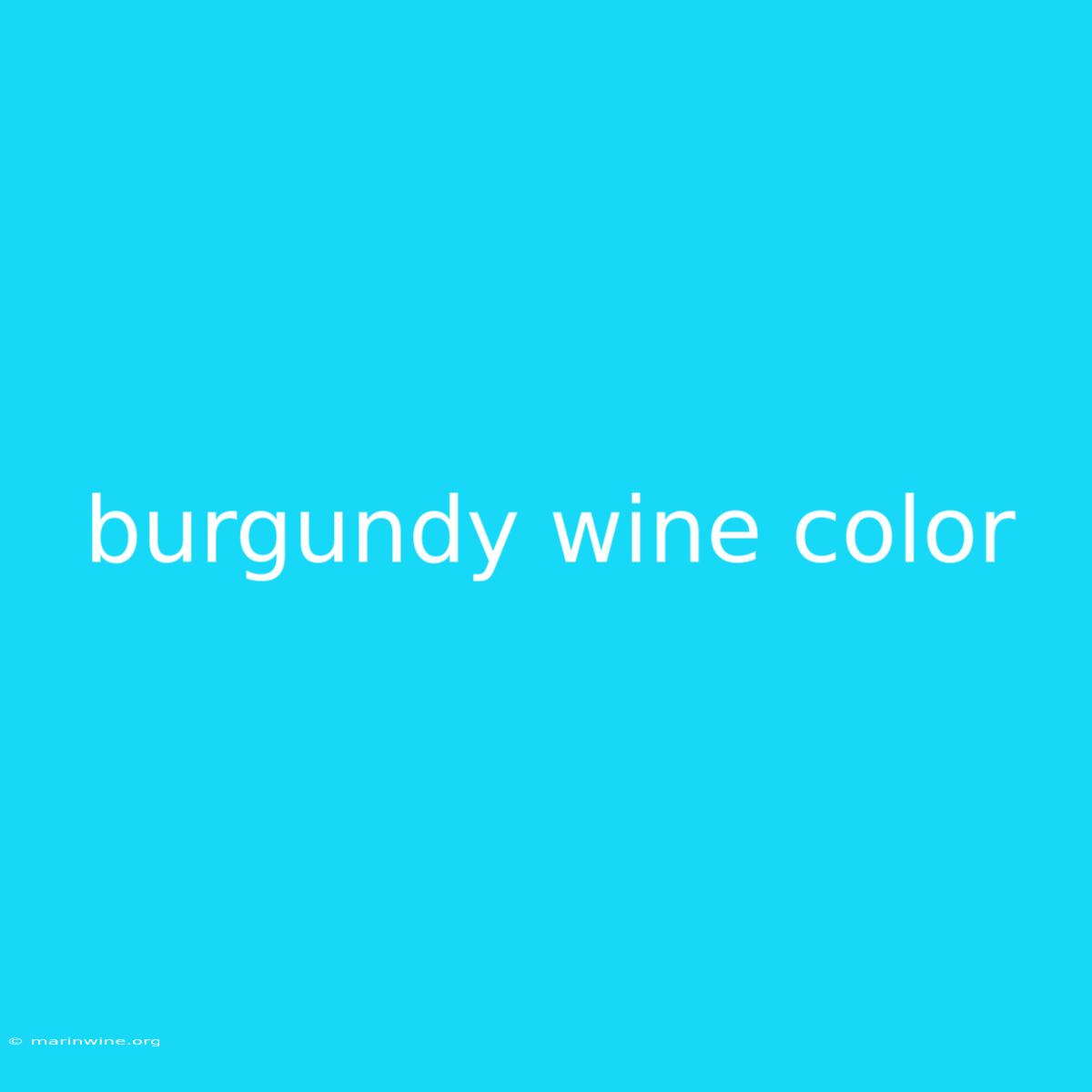The Enchanting World of Burgundy Wine Color: From Deep Hues to Subtle Variations
Have you ever wondered what makes burgundy wine so captivating? It's not just the taste, but also the mesmerizing color that draws us in. The deep, rich hues of burgundy wine are a testament to the winemaking process and the unique characteristics of the grapes used.
Why It Matters: Understanding the nuances of burgundy wine color is essential for both wine enthusiasts and professionals. It provides insights into the grape variety, aging potential, and overall quality of the wine.
Key Takeaways of Burgundy Wine Color:
| Feature | Description |
|---|---|
| Origin: | Burgundy wines derive their distinctive color from Pinot Noir grapes, known for producing wines with a range of hues. |
| Factors Influencing Color: | Factors like vineyard location, soil type, and winemaking techniques significantly influence the color intensity and depth. |
| Color Spectrum: | Burgundy wines can range from pale ruby to deep garnet, with varying degrees of brick red and purple tones. |
| Aging Effects: | As burgundy wine ages, its color evolves, becoming more amber-toned with hints of brown, showcasing its maturity and complexity. |
Burgundy Wine Color: A Deep Dive
Pinot Noir: The Foundation of Burgundy Wine Color
The foundation of burgundy wine color lies in the Pinot Noir grape. This delicate and versatile grape is known for its thin skin and moderate tannins, producing wines with a wide spectrum of colors. The skin of the Pinot Noir grape contains pigments called anthocyanins, which contribute to the red and purple hues characteristic of burgundy wine.
Factors Affecting Color Intensity
The color intensity of burgundy wine is influenced by several factors:
- Vineyard Location: Burgundy wines from cooler regions tend to have lighter colors, while those from warmer regions often exhibit deeper, richer hues.
- Soil Type: The soil composition plays a crucial role in the color development of the grapes. For example, wines produced from limestone-rich soils often have a bright, ruby red color.
- Winemaking Techniques: Techniques like maceration, fermentation, and aging influence the color extraction from the grape skins.
Color Evolution and Aging
Burgundy wine's color evolves with age, adding to its complexity and charm. As the wine ages, the anthocyanins gradually break down, resulting in a shift towards amber and brown tones. This transformation highlights the maturity of the wine and reveals its nuanced aromas and flavors.
Exploring the Connection Between Color and Taste
Burgundy wine color provides clues about its potential flavor profile. While color alone isn't a definitive indicator of taste, it can offer insights into the wine's overall character:
- Lighter Burgundy Wines: Often exhibit bright fruit flavors with a lighter body.
- Medium-Bodied Burgundy Wines: Typically display a balance of red fruit flavors with a hint of spice and a medium-bodied texture.
- Full-Bodied Burgundy Wines: Tend to have concentrated flavors of dark fruit, earthiness, and a robust structure.
Burgundy Wine Color: A Spectrum of Nuances
Here's a deeper look at the various color nuances found in burgundy wine:
Pale Ruby: Young burgundy wines often exhibit a pale ruby color, indicating a lighter style with bright fruit flavors. Ruby Red: As the wine develops, it acquires a ruby red color, signifying a more complex flavor profile with a hint of spice. Garnet: Mature burgundy wines often display a garnet color, suggesting a full-bodied character with dark fruit flavors and a hint of earthiness. Brick Red: With further aging, the color may shift towards brick red, indicating a well-developed wine with a range of tertiary aromas and flavors. Amber: As the wine ages significantly, it may acquire an amber hue, highlighting its advanced maturity and complexity.
FAQ:
Q: Can I tell the quality of a burgundy wine by its color? A: While color provides clues about the wine's age and potential flavor profile, it's not a definitive indicator of quality.
Q: How does the color change with different grape varieties used in burgundy wine? A: While Pinot Noir is the dominant grape in Burgundy, some producers use small amounts of other grapes like Gamay and Chardonnay. These blends can create variations in color, but Pinot Noir remains the primary driver of the characteristic burgundy hues.
Q: How does the winemaking process impact the final color of the wine? A: Winemaking techniques like maceration and fermentation play a significant role in extracting color from the grape skins, influencing the final color intensity of the wine.
Q: What is the best way to observe the color of a burgundy wine? A: Hold the wine glass against a white background and observe the color at a slight angle. The light will illuminate the nuances of the wine's color, allowing you to appreciate its depth and intensity.
Tips for Enjoying Burgundy Wine:
- Serve burgundy wines at the appropriate temperature: The optimal serving temperature for burgundy wine is between 55-65 degrees Fahrenheit.
- Use a clear glass: A clear glass will allow you to fully appreciate the wine's color and its evolution with time.
- Pair burgundy wines with the right food: Burgundy wines are versatile, but they pair particularly well with dishes like roast chicken, lamb, and mushroom-based recipes.
- Consider the age of the wine: Young burgundy wines are best enjoyed young, while aged burgundy wines can benefit from further development and complexity.
Summary of Burgundy Wine Color:
This article explored the captivating world of burgundy wine color, highlighting its significance as an indicator of grape variety, aging potential, and overall quality. From the deep hues of Pinot Noir to the subtle variations caused by vineyard location and winemaking techniques, burgundy wine color offers a glimpse into the fascinating world of winemaking.
Closing Message: The next time you savor a glass of burgundy wine, take a moment to appreciate its mesmerizing color. It tells a story of tradition, craftsmanship, and the captivating journey of wine from vineyard to glass.

